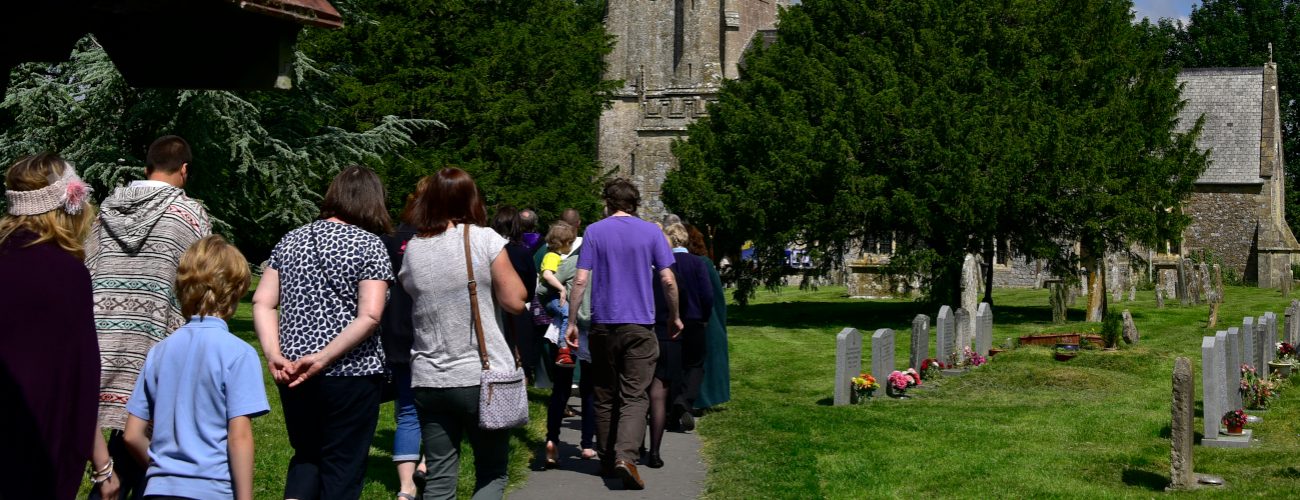
Pilgrims
We may be eight villages in rural Wiltshire however our links and involvement in organisations is rather broad – local, national and international. Many of those you will meet in our churches give their time generously to other organisations.
Pilgrim History
Between the 10th and 16th century Pilgrims staying overnight at Fyfield, Winterbourne Basset and Berwick Basset Churches came to St James Avebury for an early morning service. After Mass and Blessing they left on Pilgrimage to Santiago Di Compostela, Rome and Jerusalem through the West door of the church, with the Saint’s blessing protecting them. Many of them would never return – some left their marks and carvings on the wall and all our churches are rich in Medieval Graffiti.
At Avebury church the meaning of an Anglo-Saxon carving external to church long held as being something related to land ownership has recently been identified as a rare and stylised version of the cockle shell of St James. Palmers, on pilgrimage on behalf of those unable to go to fulfil a penance or other religious obligation, travelled with this medieval badge of pilgrims, adapted from original. This early depiction of badge of the Palmers located on the external North wall of the church date it as being of 10th or 11th century – Marking a time when at last one COULD go on pilgrimage i.e. towards the end of the Anglo Saxon- beginning Norman period in history and this emblem would once have featured as part of the original door to the church.
The Church was refaced by the Victorians so there is little more to be seen externally. However, the CUSP is Norman – not a grave stone as originally thought- and is a deliberate emblem and sign of the Pilgrims way. The external surfaces of the Tower have some pilgrim crosses of both Pilgrims to Jerusalem and Santiago Di Compostela but very few in comparisons to other churches in the Benefice. Most of the pilgrimage graffiti and other evidence were removed during the Victorian period.
Avebury: Interior Walls: Crosses, and ‘circle and cross’ depiction of Spiritual Cosmology and are also to be found at Winterbourne Basset. These circles paint a vivid and moving medieval view of universe. Consisting of 5 individual rings, the central circle depicts Jerusalem, the site of the Crucifixion and resurrection of Jesus. It is in Jerusalem that Christianity had its birth through the death, resurrection AND ascension of Christ. The second circle depicts the human world, followed by a 3rd circle of angels, a 4th circle of Archangels, then the 5th circle of the Universe , cut through by a single line- representing the hand of God pointing downwards towards the Earth, sending Holy Spirit onto Christ. Here in Avebury the Cosmic Circle was rather crudely made never finished, perhaps begun by a priest. It is possible that the Amazing face 14th cent Berwick Basset Church is also a depiction of St Michael.
Medieval letters carved into the wall circa 1500 is almost certainly a Latin inscription carved by a priest or prayer. Surrounded by a large number of pilgrim’s crosses is another inscription and the wall is riddled with graffiti.
St James Avebury remains a place of pilgrimage today and welcomes visitors of all faiths, and none, all nationalities.
The Confraternity of St James are a UK-based charity established to promote the pilgrimage to the shrine of St James in Santiago de Compostela. We provide a range of information services to assist prospective pilgrims, of all religions or none, who are planning a walking, cycling or horseback journey along one of the many Camino de Santiago routes.
As part of its Aims and objectives, the Confraternity of Saint James undertakes and promotes research into the history of the pilgrimage, and the cult of St James in Britain, and also takes an active part in identifying and safeguarding monuments and works of art connected with St James and the pilgrimage.
The Camino de Santiago (the Way of St. James) is a large network of ancient pilgrim routes stretching across Europe and coming together at the tomb of St. James (Santiago in Spanish) in Santiago de Compostela in north-west Spain.
The history of the Camino de Santiago goes back at the beginning of the 9th century (year 814) moment of the discovery of the tomb of the evangelical apostle of the Iberian Peninsula. Since this discovery, Santiago de Compostela becomes a peregrination point of the entire European continent.
The Way was defined then by the net of Roman routes that joined the neuralgic points of the Peninsula. The impressive human flow that from very soon went towards Galicia made quickly appear lots of hospitals, churches, monasteries, abbeys and towns around the route. During the 14th century the pilgrimage began to decay, fact brought by the wars, the epidemics and the natural catastrophes.
